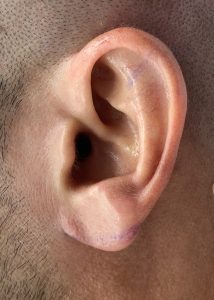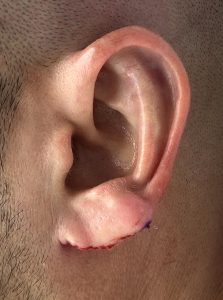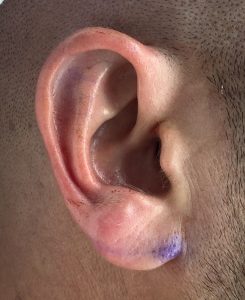Background: Aesthetic surgery of the ear is commonly called otoplasty. This term is really a generic term that doesn’t really indicate what type of ear reshaping procedure is being done. Because the most common aesthetic ear reshaping surgery is historically for protruding ears, otoplasty is most commonly associated with ear pinning or a setback otoplasty procedure.
But there are numerous aesthetic changes that can be done, particularly to the adult ear, that often go unrecognized. Changing the shape and size of the earlobe, a well known procedure change, can be done although the most common earlobe reshaping procedure performed is a torn earlobe or gauged earlobe repair. Changing the angulation of the ear to the side of the head, either closer to or even further away, can be done for changes that are far more modest than what is commonly perceived as a setback otoplasty. Helical rims can be trimmed if there is too much overhang on the superior ear. Excess cartilage bumps called Darwin’s tubercle for example can be removed to smooth out the helical rim.
While many of these ear shape changes can be relatively minor, they may take on great aesthetic significance in one unique type of patient…one with a shaved head which is a common ‘hairstyle’ in men today. In a shaved head the only topographic feature seen is the ears. (provided the skull is otherwise smooth) They literally stand out much more than in any one with hair as they are more exposed. Ear features that are typically in the normal range may appear more exaggerated because of their isolation.
Case Study: This shaved head male was undergoing a skull reshaping procedure and desired to have his ears worked on at the same time. He was bothered by the upper ear sticking out just a bit too far and earlobes that were a bit too long.
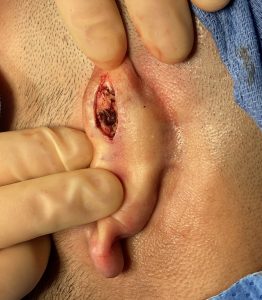
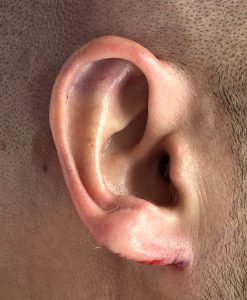
I have seen many shaved head males for ear procedures to make their ears stick out less or be smaller in size. Even small changes when collectively put together can make a very visible change for a smaller better shaped ear.
Case Highlights:
1) An adult aesthetic otoplasty can be a finesse procedure with minor alterations to numerous areas of the ear for an overall effect.
2) In the adult male with a shaved head, the shape and position of the ears on the side of the head takes on greater aesthetic significance due to increased visibility.
3) In the shaved head patient a ear that may be normally considered too close to the side of the head may not be when it is more fully exposed..
Dr. Barry Eppley
World Renowned Plastic Surgeon



